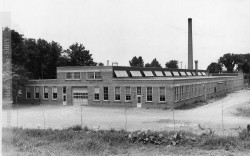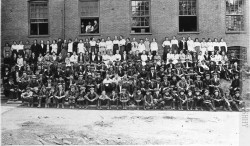A bit of History

Miner Rubber, 1935. The rubber plant was served by the railway Canadian National. © Fund Horace Boivin, Industrial Commissioner, Historical Society of the Haute-Yamaska
It can be said that industry made Granby. It was the industrial sector that spawned the growth of the city and made it a hub of the region. Few other Quebec communities enjoy an industrial tradition as strong as that of Granby, a city that exemplifies efficient cooperation between citizens and business leaders.
In 1881, Granby, Acton Vale, Farnham, Waterloo, Cowansville and Roxton Falls were villages of a comparable size that were competing for development. One clear winner emerged as the communities tried to attract industry with a number of financial incentives, including direct subsidies, interest-free loans, tax breaks, and stock purchase. In 1910, economic data showed that Granby had successfully industrialized. This success is largely due to the commitment of Stephen Henderson Campbell Miner and a number of others who had the expertise to promote business development in Granby, primarily in the rubber sector (Granby Rubber, 1882) and tobacco (Imperial Tobacco, 1895).
At the beginning of the 1930s, a rapidly developing Granby became one of the 15 cities in Quebec with a population of over 10 000. However, the industrial economy enjoyed little diversity; Miner Rubber, Imperial Tobacco and Granby Elastic Web employed 2 500 of the 3 000 factory workers in the city. Between 1929 and 1932, as the depression threatened to eliminate industrial jobs, five American subsidiaries, of which four were textile companies, helped diversify the economy by setting up shop in the city. All but one employed more than 100 workers by 100 and the largest of them, Esmond Mills, created over 300 jobs. This influx of external capital made it possible for Granby to diversify its economy and limit the impact of the Depression, which helped it maintain its position as a major industrial centre in Quebec.

Workers of the Nordic Hosiery Limited, an American company established in silk stockings 1929 Denison Street East. © Historical Society Collection Haute-Yamaska
Under the administration of Mayor Horace Boivin, Granby experienced a golden age of economic development between 1939 and 1964, spurred by the growth of industry. This booming era brought the number of factories in the city from 30 to 100 and the value of industrial production from 12 million to 100 million dollars. While the low salaries may have fostered the enthusiasm of local and outside investors, the innovative spirit of Granby’s business leaders, led by Mayor Horace Boivin, must also be taken into account. Boivin did everything at his disposal to attract investors so that he could secure the future of the city. His tenure as mayor was marked by a continuous quest for new capital. He travelled abroad or across Canada on missions to prospect for and solicit potential new investment.

Photo left: Carl Stohn the workers, a manufacturer of curtains and fabrics established in 1924, rue Saint-Charles. @ Fund Valère Audy photo: Leader Mail Granby, Historical Society Haute-Yamaska
Photo right: Carl Stohn around 1930. In 1944, the company became the property of the Verney Mills and ten later, it passed into the hands of Hafner. © Fund Horace Boivin, Industrial Commissioner, Historical Society of the Haute-Yamaska

The packaging pipe tobacco at Imperial Tobacco, circa 1955. © Fund Gerald Scott, photo: Studio Granby Historical Society Haute-Yamaska
Signed in 1947, the GATT agreements facilitated globalization of trade. This liberalization led Granby to embark on a long road to industrial redevelopment; in the 1970s and 1980s, the traditional sectors of tobacco and rubber manufacturing disappeared and the textile industry was threatened. Fortunately, the iron, steel, plastics, electronics and food services industries managed to fill the void left by the closures and layoffs. This development also reduced the size of companies, 70% of which employed less than 50 workers in 1960.

It was in 1930 that the Stedfast Rubber, a company in Boston, moved to Granby. Towards the end of the autumn of 1941, she moved into the new building. The company manufactures waterproof materials for various uses, including medical and military. © Fund Horace Boivin, Industrial Commissioner, Historical Society of the Haute-Yamaska
The 1960s were a particularly tough period for Granby industry, with the loss of 2 000 jobs and little new investment. The following decade reversed this trend, as the 1970s marked another period of growth. The renewal of industry in this period was largely due to financial incentives created by the federal, provincial and local governments to encourage local and outside business people to invest in Quebec. Granby was not left out, in the mid-1960s, a consultative commission was formed and the industrial fund of the city was raised to 1.5 million dollars. In 1967, the industrial park opened.
Regarding the source of capital, the 1960s-1980s were characterized by the withdrawal of American investment and the influx of European capital. This foreign investment was no accident, at the end of the 1960s, the federal and provincial governments wanted to reduce the dominance of US investment, so they solicited capital from investors in Germany, France, the UK and Italy. At the municipal level, former mayor Horace Boivin was named industrial commissioner in 1969, which gave him the mandate to convince Europeans to invest in Granby. He was so successful that a journalist for Montreal’s Le Devoir newspaper called the city ‘The Little Europe of the Eastern Townships’ due to all the European industries in the city. Currently, 32 European companies operate in Granby, creating 1 700 jobs, a fourth of the city’s labour force.
After some time, subsidies were abandoned and international business conditions worsened which led to a reduction in foreign investment and forced economic stakeholders in Granby to focus their attention on developing local potential. By shifting the perspective to local and Canadian growth, the city returned to the foundations of its industrial development. While the city had relied on European investment in the past, it was the innovation of local and Canadian industry that made it possible to renew itself as it has continued to do. The vitality of its ability to develop local capital was exemplified during the industrial shift between 1960 and 1980. In 1984, Georges Nydam, the director of the Granby Industrial Commission, assessed that 70% of job growth was generated by local businesses. Among the 124 local or Canadian companies created after 1964, only 17 employed 50 or more workers in 1986, which demonstrates the importance of small businesses in the process of industrial development.
Local and Canadian capital plays a part in all sectors of activity, but the importance of local investment varies. Forestry and printing, for example, are entirely dependent on local capital. In 1986, more than 800 workers were employed by plastics or chemical companies, another sector that is almost entirely controlled by local interests. The Canadian contribution to the textile and clothing industries has made it possible to revitalize a sector that was significantly affected by market development. All clothing manufacturing companies are directed by women, a sign of the times. The metallurgical sector enjoyed the most significant growth between the 1960s and 1980s, creating 50 companies, 43 of which were from a local or Canadian initiative. The Granby Agricultural Cooperative was a huge success, becoming Agropur In 1979, expanding its territory and continuously diversifying production. It began as a simple regional co-operative in the 1960s, and has been transformed into an agri-food giant that processes 40% of milk products in Quebec and generates 800 million dollars in economic activity.
For regional and Granby industries, the end of the 20th century signalled liberalization and globalization of world markets and one of the largest periods of economic growth in the postwar era. In Granby, where the positive effects of free trade are still being felt, industrial workforce grew by 30% and commerce enjoyed a period of renewal. All industries in the region seem to have benefitted from the reduction in tariffs that have been in effect since the end of the 1980s. The innovative spirit of the business community was another catalyst for success in that period; organizations and associations representing businesses adapted brilliantly to the challenges of globalization, as well as regional integration.
The industrial sector has retained its position as a generator of growth in Granby, spurred by free trade. Following a difficult period of layoffs at the beginning of the 1990s in which 1 200 jobs were lost, the number of factory workers rose significantly between 1992 and 1999, increasing from 7 000 to 9 100. Small and medium-sized businesses continue to dominate the industrial fabric; at the end of the 1990s, 220 production units were operating in seven main sectors. In order of number of jobs they have created, these sectors are: metal processing; electronics; textiles and clothing; rubber and plastics; food and beverages; printing and paper; and wood processing.
Today, as it was in the past, the people of Granby know that we can only count on ourselves to guarantee our development. While other regions in Quebec grow and prosper by exploiting natural resources such as wood, seafood and minerals, and while cities decline because of withdrawal of US investment, our human capital is what made it possible for Granby to succeed and to become one of the most important cities in Quebec. What would our human capital be without the courage, innovation, determination and ingenuity of the men and women of Granby?
By Mario Gendron
Haute-Yamaska Historical Society.






